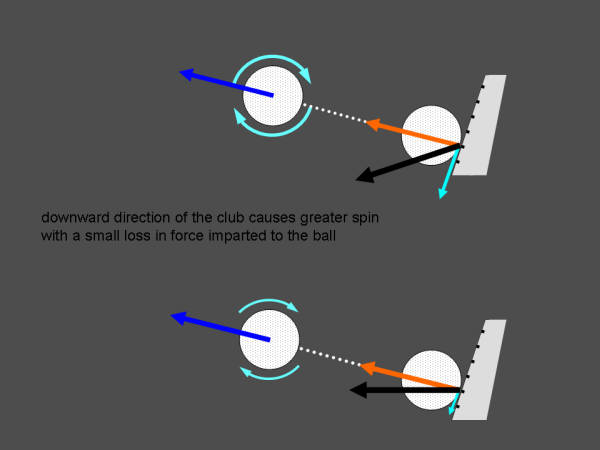
What's Up With Loft?
The forces from the club to the ball
When a golf club strikes a golf ball, the club is moving in a forward direction, but the loft of the club is angled upward, so the ball takes off in a direction perpendicular to the clubface. When the loft is low and the clubface closer to upright, most of the force of the club is directly transmitted to the ball because the club's face and direction are more closely aligned. When the loft is high and the clubface angled more upward, not as much force from the club is transmitted to the ball. This is because only the component of the club's force that is perpendicular to the clubface gets applied to the ball.
Consider an extreme example of the loft of the club being 90 degrees, so the face was oriented straight up. With the club moving forward, there would be no force imparted to the ball as the club would merely slide right under the ball with no component of its direction perpendicular to the face. With more moderate amounts of loft, the component of the club's force that is oriented perpendicular to the face varies with loft. How much force the club transfers to the ball has a significant influence on how far the ball travels. This is a reason why lower lofted clubs hit the ball farther, because they apply more of their force to the ball's direction than higher lofted clubs.
The force that the club generates in its direction of motion can be separated into two components, one perpendicular to the clubface that impacts the ball in that direction, and another parallel to the clubface that imparts spin.
Since the loft of the club is the same, the ball departs at the same angle perpendicular to the face, but with more spin due to the different path of the same club. This is different than using greater loft to generate more spin, which also causes the ball to fly higher because it will start its flight perpendicular to the greater loft.

A higher lofted club produces more spin than a lower lofted club because its face is closer to parallel to the direction of the club, so the frictional force component is greater. In order to generate friction, there must be some force perpendicular to the face so the ball is pressed against the club in order to receive frictional force from the club. While the perpendicular force is reduced with loft, it is still sufficient to contact the ball and transfer friction from along the club's face into spin on the ball. The component of the club's velocity parallel to its face increases with increasing loft, so spin is enhanced.
Both the ball's speed and spin are altered due to loft. Another way to affect these factors is by altering the club's direction. Hitting the ball with the club moving in a downward direction changes the angle of the club's force. The component of that force that is perpendicular to the clubface is slightly reduced (if the club direction were parallel to the face, no force would be applied to the ball). The component of the club's velocity parallel to the clubface is significantly increased with a downward moving club, so greater spin is imparted to the ball.
